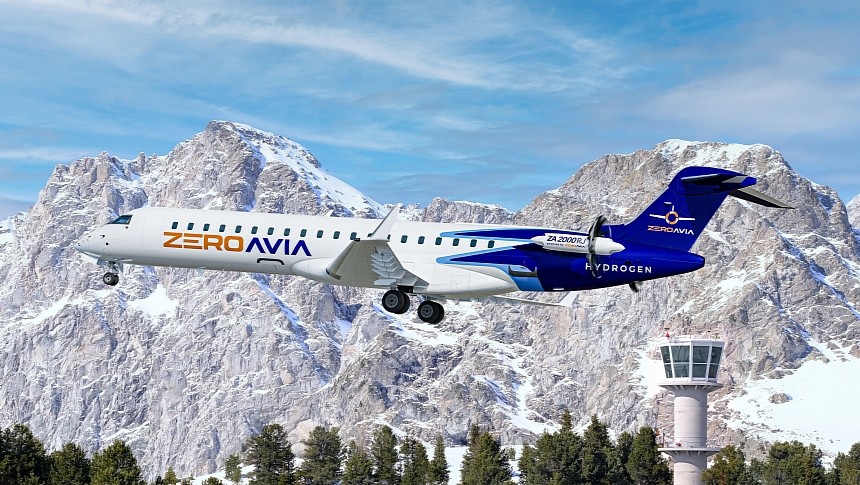Can an aircraft crowned "world's most successful regional jet" get even better? The answer is yes if we're looking at emission levels. Two industry players have joined forces to research the possibility of converting existing regional aircraft into zero-emission jets with hydrogen-electric propulsion, and the first results look promising.
ZeroAvia is one of the top names in hydrogen-electric aviation. It has already reached impressive milestones during flight tests. Also, it has obtained experimental certificates from the FAA (Federal Aviation Administration) and CAA (UK's Civil Aviation Authority) for its three prototype aircraft. It supports retrofit projects as the fastest route to zero-emission commercial flights. Its latest endeavor is a partnership with MHIRJ, with the prospect of retrofitting CRJ jets with its ZA2000 propulsion system.
The CRJ claims to be the pioneer of regional jet transportation, unsurpassed to this day. Airlines love it because of its low trip and seat costs, making it better than any other regional jet. This value advantage comes from a specific design combining a lightweight structure, top-notch aerodynamics, and optimized engines and winglets.
The aircraft family starts with the CRJ550, with 50 seats and a 1,000-nautical mile (1,852 km) range, ending with the CRJ1000, which boasts 104 seats and a range of 1,650 nautical miles (3,000 km).
With this partnership, the CRJ500, 700, and 900 could swap their conventional engines with ZeroAvia's alternative propulsion system for regional jets (derivatives of the ZA2000). Following the proven ZA600 propulsion unit for 19-seat aircraft, the ZA2000 system was designed for regional turboprop aircraft with 40 to 80 seats. ZeroAvia is close to kicking off flight tests for a 76-seat Dash 8-400 retrofitted with the ZA2000 and getting certification by 2027.
Together with MHIRJ, ZeroAvia started a technical study in 2022 for the potential of equipping CRJ jets with hydrogen-electric systems. Initial results show that the classic regional aircraft could switch to the ZA2000 without sacrificing current performance. According to the study, this hydrogen-electric powertrain has the potential to cover more than 80% of existing flights.
In addition to cutting emission levels, this modification would even lower operational costs, mostly by eliminating the maintenance costs associated with conventional engines.
The ZA2000 powertrain was validated during the research phase for the CRJ550, 700, and 900. This means more than 1,4000 CRJ jets could be successfully retrofitted and start operating as hydrogen-electric aircraft.
With operations in the US and UK, ZeroAvia is also working on implementing hydrogen infrastructure. Airports could become hydrogen hubs, where this alternative power source is used for aircraft and all on-ground operations. In addition to hydrogen-electric powertrains, ZeroAvia has also developed HARE (Hydrogen Airport Refueling Ecosystem), a technology claiming to be the first of its kind in the industry.
The CRJ claims to be the pioneer of regional jet transportation, unsurpassed to this day. Airlines love it because of its low trip and seat costs, making it better than any other regional jet. This value advantage comes from a specific design combining a lightweight structure, top-notch aerodynamics, and optimized engines and winglets.
The aircraft family starts with the CRJ550, with 50 seats and a 1,000-nautical mile (1,852 km) range, ending with the CRJ1000, which boasts 104 seats and a range of 1,650 nautical miles (3,000 km).
With this partnership, the CRJ500, 700, and 900 could swap their conventional engines with ZeroAvia's alternative propulsion system for regional jets (derivatives of the ZA2000). Following the proven ZA600 propulsion unit for 19-seat aircraft, the ZA2000 system was designed for regional turboprop aircraft with 40 to 80 seats. ZeroAvia is close to kicking off flight tests for a 76-seat Dash 8-400 retrofitted with the ZA2000 and getting certification by 2027.
Together with MHIRJ, ZeroAvia started a technical study in 2022 for the potential of equipping CRJ jets with hydrogen-electric systems. Initial results show that the classic regional aircraft could switch to the ZA2000 without sacrificing current performance. According to the study, this hydrogen-electric powertrain has the potential to cover more than 80% of existing flights.
In addition to cutting emission levels, this modification would even lower operational costs, mostly by eliminating the maintenance costs associated with conventional engines.
The ZA2000 powertrain was validated during the research phase for the CRJ550, 700, and 900. This means more than 1,4000 CRJ jets could be successfully retrofitted and start operating as hydrogen-electric aircraft.
With operations in the US and UK, ZeroAvia is also working on implementing hydrogen infrastructure. Airports could become hydrogen hubs, where this alternative power source is used for aircraft and all on-ground operations. In addition to hydrogen-electric powertrains, ZeroAvia has also developed HARE (Hydrogen Airport Refueling Ecosystem), a technology claiming to be the first of its kind in the industry.






